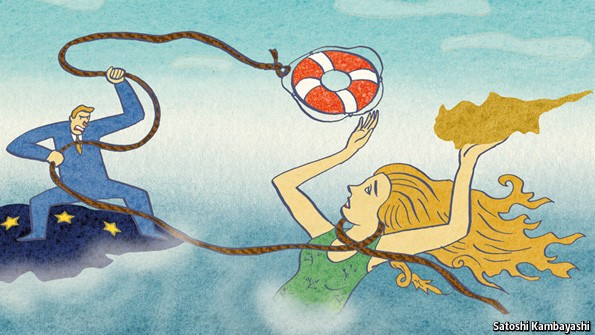The Economist explains What is a bailin
Post on: 30 Июнь, 2015 No Comment

What is a bail-in?
ON MARCH 25th, after a week of negotiations, a second rescue deal for Cyprus was agreed upon. One aspect of the €10 billion ($13 billion) bail-out deal is that it bails in the creditors of two of Cyprus’s biggest banks, the Bank of Cyprus and Laiki Bank, while sparing insured depositors. What is a bail-in?
A bail-out is when outside investors rescue a borrower by injecting money to help service a debt. Bail-outs of failing banks in Greece, Portugal and Iceland were primarily financed by taxpayers.
By contrast, a bail-in, a term first popularised in the pages of The Economist. forces the borrower’s creditors to bear some of the burden by having part of the debt they are owed written off. (In the case of Cyprus, the creditors in question were bondholders, and depositors with more than €100,000 in their accounts.) At the height of the financial crisis, governments avoided resorting to bail-ins out of concern that it might cause panic among the creditors of other banks; even the bondholders of Irish banks were initially spared. But as time has passed, and the cost of government bail-outs has risen, the appeal of asking private-sector investors to take a hit has increased. Ironically, it was one such bail-in—the restructuring of Greek government debt—that led to the problems faced by the Cypriot banks, which were big holders of Greek bonds.
The seeming success of the Cyprus deal led Jeroen Dijsselbloem. the Dutch head of the Eurogroup of finance ministers, to suggest that it might serve as a template for future rescues (though, after hours of falling share prices, he retracted, stating that Cyprus is a specific case with exceptional challenges). Anxieties remain. Many people in Cyprus feel they are being punished unduly. The capital controls that have been imposed are meant to be temporary, but similar ones are still in place in Iceland, four years after they were implemented. Foreign money will now go elsewhere while unemployment could exceed 25% in 2014. And the deal seems to move Europe away from the institutional reforms that are needed to resolve the crisis once and for all. But one thing is clear: bail-outs will now be accompanied by bail-ins. All-encompassing rescues are becoming a thing of the past.
• What else should The Economist explain? Send us your suggestions .

(Photo: AFP)
Previous
The Economist explains: How can television signals be used to track aircraft?
Next














